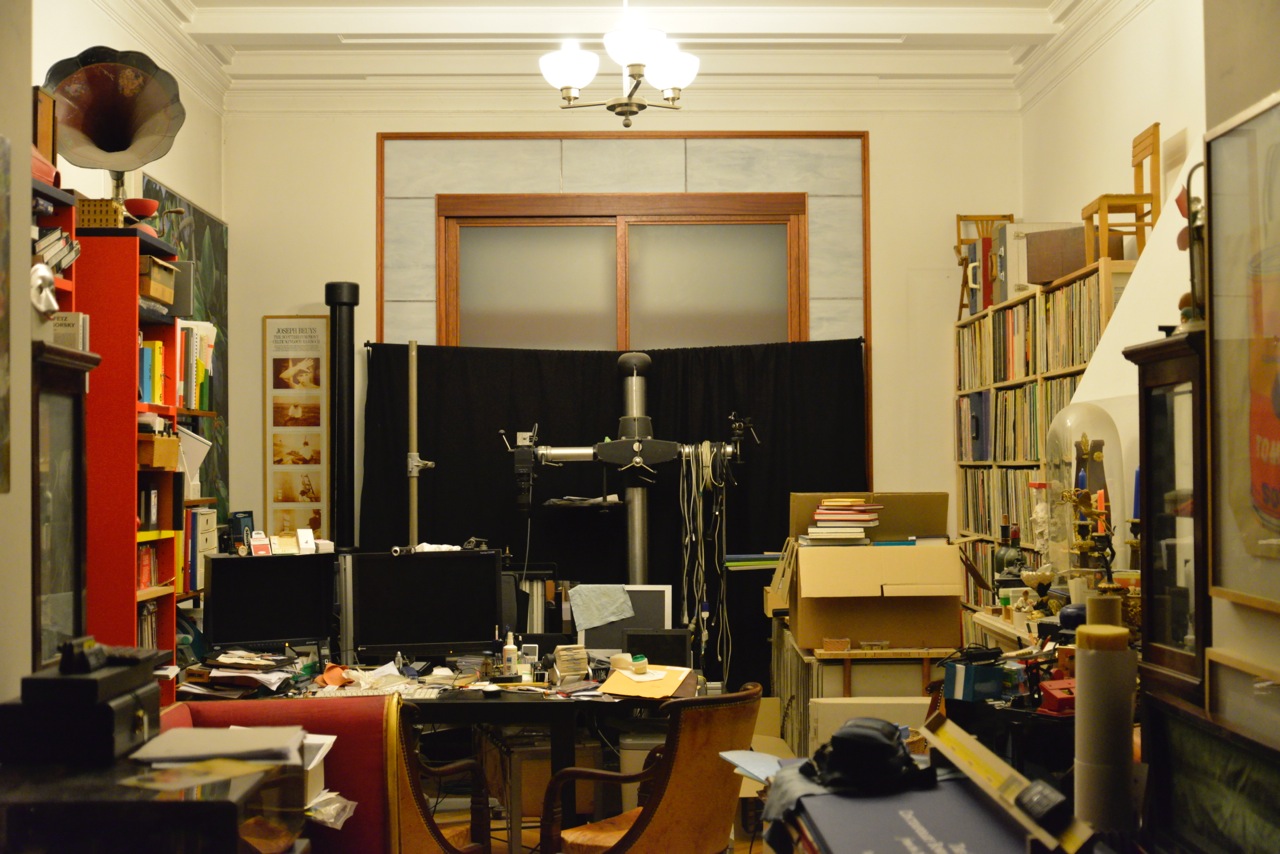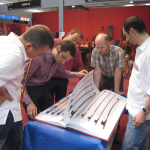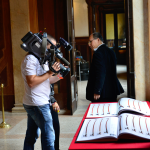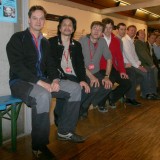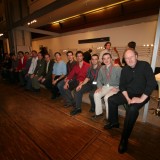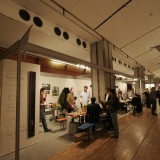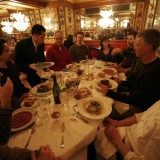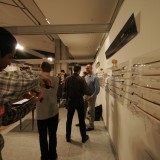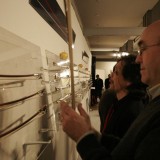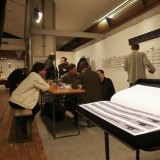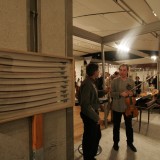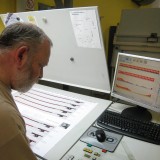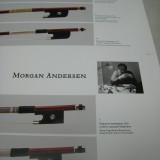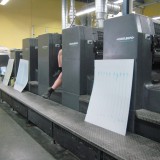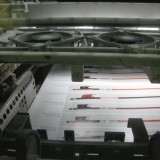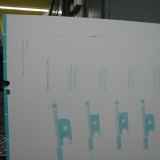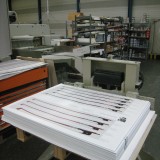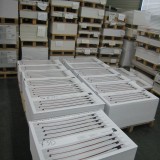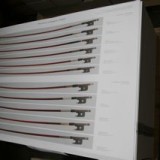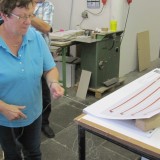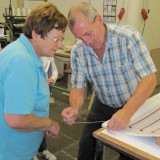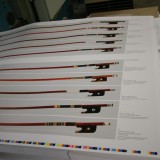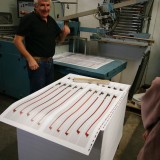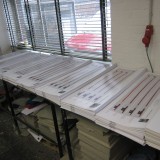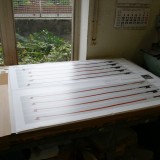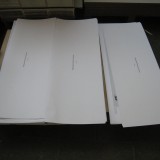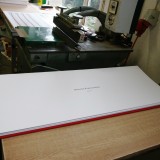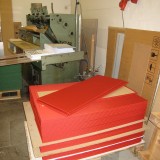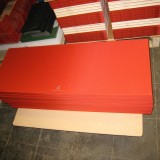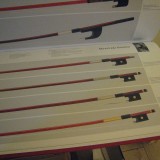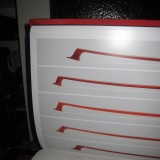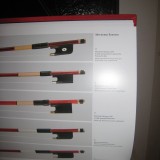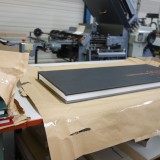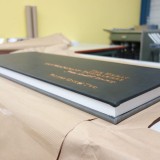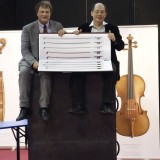This book of 8 kilogram, the first volume of two, presents 282 bows from the violin family by the following 15 great contemporary bow makers: Morgan Andersen, Alexander Aumont, Sylvain Bigot, Christoph Collinet, Franck Daguin, Arthur Dubroca, Pierre-Yves Fuchs, Josef P. Gabriel, Eric Grandchamp, Klaus Grünke, Tibor Kovacs, Yannick Le Canu, Tino Joh. Lucke, Johannes Miething, Mitsuaki Sasano.
In Volume Two 20 other bowmakers are presented.
Briefly: The final reference book on contemporary bowmaking!
Every single bow is photographed with Swiss Slit-Scan technology by Andy Lim in full-size and full-length, showing for the first time in bow reproductions not only the head and frog, but also the complete camber. Photographed in the viewing angle where it is later to be looked at, the angle of 90°, unlike traditional photography, 19 bows per bowmaker is presented (less if there are double bass bows), showing early to recent works.
This ambitious book project, conceived in 2004, after years to overcome technical challenges and the imagination of many, is finally ready to the public in 2011(after 7 years!). In the past years one could observe an ever growing demand of the premier contemporary bows, more accepted and recognized as ever before as equivalent in beauty, craftmanship and playibility. In fact very often surpassing the bows of the well respected older masters, which we all love and admire. And from the cambers documented at least we know that they are contemporary, so most probably from the maker himself.
Images of the Book Project anouncement show
Musicora, Caroussel du Louvre, Paris 2006:
The 90 cm x 35 cm Book:
The Great Contemporary Bow Makers of the 21st Century.
Here some images of the printing and bookbinding in 2011.
Volume I + II
here the preface of Vol. One:
An Address of Welcome to the Distinguished Reader
and how everything began …
After some years of Music Fair abstinence, I decided in 2004 to visit the Musicora Music Fair in Paris again, after an invitation by Gilles Nehr, when I discovered his spectacular „tête-bèche“ bow in the internet. I spontaneously called him in Lissabon, where he was living then. He was going to exhibit at the Musicora 2004 with his cousins, Jean-Pascal and Pierre Nehr at a „family-booth“. I only knew the name of Jean-Pascal Nehr, and was happy to meet the Nehr family.
There I also met for the first time some of the other contemporary bowmakers I have heard about, but actually never saw any work from. The first booth I visited, was the booth of Yannick Le Canu, Sylvain Bigot and Christophe Collinet. There were plenty of nice bows to see! Standing in front of some bows, displayed on a wall, I soon noticed someone standing next to me, also looking at the same bows. I looked to my side and saw a japanese gentleman, dressed in unformal black, sneakers and a multiple bow case in the hand. He did not look like someone from the violin trade, neither a typical asian visitor of music fairs like the Musicora, nor a musician. His way of looking at the exhibited bows though showed a very trained and professional eye. As polite as I am, I said „Hello, do you speak English?“ and got as an answer back a very brief „Yes“. As curious as I am, I was wondering what he did, so I asked him what he did. He said to my surprise that he was a bowmaker. I never have even heard from a japanese or other oriental bowmaker! Actually, not even to this day. On my request to see some of his work, he opened the bow case and I was shown a stunning quartet of bows with a style of chamfers I have never seen before. He told me by the way that he just was awarded the title „un des Meilleurs Ouvriers de France“ with that quartet of bows and a frog-copy of Jean-Dominique Adam.
I just met Mitsuaki Sasano.
Having obviously a mutual theme of interest, we got stuck in a non-stopping conversation about bows and bowmakers, as one could expect. We visited together the booth of the family Nehr. Jean-Pascal Nehr taught the art of bowmaking to his brother Pierre and cousin Gilles, who just came back to Europe. Pierre, an accomplished and today, also an established maker showed his early bows, which were already promising. Jean-Pascal showed a beautiful quartet, modelled after Tourte. The Swiss bowmaker Pierre-Yves Fuchs came by with news from the 2004 London Competition where he, as expected, was again a prize winner, another one on his list of numerous awards and medals. For Tino Lucke from Berlin, whom I met several months ago, who just received the 2004 Gold Medal in London, it was his first Gold Medal ever, beating tough competitors.
Noticable was that most people were mainly looking at the head and frogs, discussing about the proportions, style and craftmanship. For me as a cellist, still the part of the bow, responsible for the playing qualities, was the most important. But that part was seldom looked at, except for the beauty of the wood. Another thing I could find very often in contemporary bows was, the combination of aesthetics inspired by Persois, Tourte and Pajeot models with a 20th century style cambers (understandably to meet today’s overall players´ demand), but stylisticly sometimes not very matching in my opinion. This theme was discussed with Mitsu for quite some time, and my conclusion was, that by showing only the heads and frogs in all reference books, this was not going to put more attention on the camber and head-stick-frog connection. There I came up with the idea about publishing a book to document the incredible high standard of todays bow making, but at the same time the entire bow in full-size, showing the bow in its overall glory (including the stick and it’s camber).
When Mitsu told me that he lived nine years in Germany, where he started bow making, and sometimes visited his friend Josef Gabriel. I was struck by surprise to hear that name. Already at the end of the 1980s, I saw a beautiful cello bow stamped by a bowmaker Gabriel from whom I have never heard of, probably the only German bowmaker with not a typical German name!. I still remember that cello bow, an elegant Lamy style bow, exquisitely made and great to play! I told Mitsu to send my regards although we haven’t met and my compliments. When Mitsu told Gabriel at his next visit in Erlangen about my intention to make a book displaying the entire bow, it seemed that Gabriel told Mitsu to pass me on the following message; namely to give up this idea, as it was absolutely not going to work! Gabriel was sort of right, as soon as the problem of the desired 90-degree angle view on every cm of the bow came up. Everybody can notice that, for a close examination, the bow is moved from tip to frog right under the eye to obtain the needed 90 degree angle. The rules of optics prevent unfortunately the possibility of making, even from a far distance, a 90 degree photo of the entire bow, as the two outer ends of the bow will always have a non-90 degree view. Believe me, many, many tests has been done; analogue large format – via digitally stitched photos with manually pushing forwardly the bow in intervals of 10 cms – to high resolution medium format digital backs at distances up to 15 meters! Every attempt failed, until a friend who is a photo engineer, Markus M. Molthoff, told me about a project he did with his former Professor Jaroslav Poncar, who scanned the entire relief walls from the temple complex Angkor Wat in Cambodia with a custom made analogue Seitz Roundshot Panorama camera from Switzerland in slit scan technology. Markus and I then, made a trip to Switzerland. Several months later, a digital version was made based on my design. After many months experimenting with lighting, the „Project Big Bow Book“ was launched.
Convincing the bowmakers to participate was the next step. It was sometimes not easy, as many did not believe in the possibility or the necessity of such a project. Different reasons from “too much stress”, “too little time” till quite blunt und impolite rejections are now in my repertoire of favourite anecdotes about the “The making of the Big Bowbook”. Being treated like an unwelcome Jehova’s Wittnesses at the door with my enthusiastic proposal to join this freshly born and still fragile project, gave me extra energy to accomplish my intent. That’s why I decided to include their names in the list of acknowledgments at the end of this book, as they were indeed very motivating too.
At the Musicora Music Fair in Paris 2006, I presented a prototype of the book. At this fair, it was a double première: the first time that the fair took place in the „Caroussel du Louvre“ and the first time ever I participated at a fair as an exhibitor. Eighteen great bowmakers from several continents exhibiting on this 18 meter long booth made it a historical event. Six months later, in the same year of 2006, a similar presentation was done at the Mondomusica in Cremona. Five years of hard work followed; organising, scanning, shipping, organising, scanning, shipping etc. etc., days and days of assisting and helping unraveling the hundreds of files, each with confusing names like „Bigot-violin-SE-2011-okt-2006_0329_014939.bmp”, “Dubroca-violin-ivory classique-dunkel.psd“ or „LeCanu-violin-GT-2007B2007_0312_113355.tif“.
Finally this publication could be realized, only with special thanks to the challenged and helpful Marco Lietz, whos´ experience and competence turned this project visuably in printed matter. Printed with greatest care and every book being stitched and bound by hand, both in Germany, the utmost effort possible was made to document the passion, both of this project and the bowmakers, undiluted and unbiased. The ultimate goal was to present this to the distinguished bow- and book enthusiast, without loosing any of the initial megalomania and idealistic pureness.
Although the journey, once upon a time, started naively to accomplish this book (only the first volume even after seven years) was exiting, it did cause a certain amount of stress. At the same time it brought me many new experiences and friends. But above all, the feeling of arriving at the longed-for destination is uncomparable! Arriving at the destination I sincerely endeavour to reach, is what always counted for me, and not – as buddists quite often seemingly favour – the journey itself.
Today, in the year 2011 and after 7 years, the „Big Bow Book“ is printed and bound. Today. the initial sceptic and doubter Josef Gabriel became in the meantime a dear and close friend. Volume One is ready to be presented to an interested audience, maybe eventually owned by the few privileged connoisseurs and admirers of the Contemporary Art of Bowmaking, who sincerely appreciate it. This publication shows of each maker 19 examples, works from earlier periods to the present time. Sylvain Bigot finished the latest bow only 14 days before the scanning, processing, the lithograhy and the actual printing! Those who understand the intentions and ambitions of this project will discover a world of creativity in this publication, combined with the display of the highest craftmanship in bowmaking ever reached. Only through the collective effort, passion and enthusiasm of 15 talented bowmakers, their work and my humble self, it was possible to present in Volume One (of two intended volumes) the 285 pictured beautiful bows. And this in a way, before for many not imaginable: my unconditionably desired 90 degree view of the entire bow in full-size print!
As a „bonus“, 15 Violoncello bows, each created and mounted at my request for this project with a Micro-photo lens, as a hommage to the picture bows of the great Jean-Baptist Vuillaume. But this time it is not Vuillaume, Stradivarius or the Octobass to be discovered in the tiny lens, but the beloved Shar-Pei dog Darling II., the publisher’s mascotte (Darling I. was the name giver of the publishing house since 2002). This little dog was six months old at the time of the launch of this project in Paris 2004. Since the beginning of this project, he witnessed so many bowmakers making an exceptional Micro-photo lens cello bows inspired by his portrait.
So today I am grateful that – although it took quite long – this mammoth project succeeded. And I am convinced that ”The Great Contemporary Bowmakers from the 21th Century – Volume One“ was worth waiting for, as it will be the same for the Volume Two, in which more bows not only from the established makers like Stéphane Thomachot, Charles Espey, Noel Burke, Edwin Clement, Robert Morrow, Ole Kanestrom, the Nehr & Grunberger family etc. etc. can be expected, but also the rising stars of tomorrow’s generation of great bowmakers.
I wish the reader a great time with the following 285 bows!
Andy Lim, Cologne, 2011
Prefaces from some bowmakers:
Morgan Andersen:
1
Sometime in 2005 I received a phone call from someone who introduced himself as Andy Lim. He mentioned that some of my colleagues had told him to contact me about a project he had in mind and he proceeded to describe an early concept of this book. I found him amiable, refreshingly honest and stimulating to talk to but frankly did not know what to think about his book idea. I held off judgment until we had a chance to discuss things further and to see if he followed though with developing his ideas.
As we spoke over the following year I began to see that he was serious about making a book of full length photos of contemporary bows. I learned he was experienced in book publishing and knew what he was getting into. While not independently wealthy, he had spent a small fortune on the equipment needed to produce this book and was in the process of building a significant bow collection. He was also promoting contemporary bows in a number of other ways.
As a cellist and collector of bows he had become aware of how important the choice of wood, graduations and camber are to defining the quality of the final product. A book that has photos of either end of a bow can not relate these aspects to the viewer and thus was born Andy’s vision of a book of full length bow photos. He has proved to be as obsessed with overcoming the difficulties of producing such a book as he is with bows themselves and considers the form of a book as an artistic statement in itself separate from but complimentary to its content.
2.
I found many of Andy’s ideas interesting, rather unique and in opposition to conventional approaches to business. The more time he had to explain his bow book idea to me the more he seemed unrealistically wedded to a concept of uncompromising quality and perfection. I had warmed to him as a person but I wondered if he might be a little crazy. The project he described, while wonderful, made no economic sense. What he wanted to do would be horribly expensive to produce and have an extremely limited audience. Would anyone in their right mind follow through with such a plan?
Not only was he taking on a huge endeavor himself with the book, he was asking a significant amount of time and effort from all of those who were to be its subjects. After much thought I told him I didn’t think I would participate. I felt it could be a costly distraction that had a rather high risk of failure.
After a period of not communicating, Andy began calling again to talk about bows and to tell me of progress on and changes to the book. We realized we were both going to be in New York at the same time in 2008 and arranged to meet. The following year I traveled to Germany where we spent more time together.
Ultimately, Andy’s degree of interest in contemporary bows and their makers and his passion for realizing his personal vision of a book on the subject became impossible to resist. Despite my initial reservations, I found myself drawn to be a part of it.
.3.
If lacking a certain type of reason is crazy, then my early concern that Andy might be a little crazy has proved to be true. But he is crazy in a wonderful way that makes the world a more interesting place. People who have a vision and pursue it purely for their conviction and not because it makes economic sense may not be the most rational people, but they hold the potential to produce things of unique artistic merit.
I believe it is this quality in Andy to pursue a passion at all cost that has resonated with many of today’s foremost contemporary bow makers. Taking the time to make a bow the very best you can, finding the most exceptional materials and being uncompromising in every detail of your workmanship and style is what makes bow making interesting to many of us, but it is far from being the most economically rational approach to the business. We recognize something of a kindred spirit in Andy and yet are still amazed at the lengths he has been willing to go to produce a document of our work unlike any other.
It has been an honor to be a part of this project and I sincerely hope it inspires not only as a record of bow making at this point in time, but as a symbol of pursuing one’s visions. This book and the man that made it embody that timeless aspect of the artistic ideal.
Yung Chin
Many years ago I received a phone call at my shop in New York City from a gentleman in Europe looking to acquire some cello bows. I had never heard of this person and the caller let me know very quickly he was very sure of what he would like to acquire. He presented his thoughts in a very forward and rather direct manner. This was my first and only contact with Andy Lim for many years. Years later, I met Andy in person for the first time at Musicora in Paris. We had an extended discussion on many subjects and he reminded me of our first phone call years before. Oh, now I remembered him! After meeting him in Paris, I understood my first phone call many years before in a much better light.
The contemporary bow book is a fascinating project for all those involved. It is not only beneficial to the makers and aficionado of bows but the concept and the technology of the book has great potential to be applied to many other subjects besides bows. Only Andy could come up with such a grandiose book project and we thank him for his prodigious effor
Josef P. Gabriel
Lieber Andy,ich denke ich konnte so ziemlich von Beginn an, an Deinem verrücktenBogenbuchprojekt, ein wenig teilhaben. Nach der langen und arbeits -intensiven Zeit für Dich, freue ich mich jetzt sehr auf das Buch. Durch die jeweils 19abgebildeten Bogen, bekommt man einen guten Einblick indie Arbeit des jeweiligen Bogenmachers. Dem Betrachterwünsche ich viel Spaß mit dem beeindruckenden Buch.
Eric Grandchamp
Bien que ce livre nous paraisse démesuré, j’aimerais encore élargir le format de cet ouvrage en y associant toutes les personnes qui, en coulisse, ont contribuées a ce succès.
Mes premières pensées vont vers Andy Lim & Suzy qui ont eu un immense courage de conduire ce projet.
Quel bel hommage à nôtre Maître Bernard Ouchard dont son subtil enseignement a su façonner une nouvelle génération d’archetiers si riche en créativité !
Et enfin, je n’oublierai pas ces femmes d’archetiers qui supportent au quotidien la passion dévorante de nôtre métier.
Klaus Grünke
When Andy Lim approached me a couple of years ago with his idea of a fullsize bow book on modern makers, I was quite sceptical, I have to admit. But after visiting Andy and viewing his highly advanced technical and photographic equipment together with his dedication for the project, I changed my mind and joined in. In the years to come we established a very good working relationship which turned into a friendship. The makers invited and involved in this exceptional book project represent an exquisite selection of today’s bow making from around the world. The overview of those craftsmen’s works of art in diferent stages of their career is a documentation to last. In this full size format, the viewers of this picture book will get a whole new look at the artistically tool called the bow. The opportunity to observe and compare the entire stick with its bending and graduation makes the impression of a bow complete, no more nor less.
Yannick Le Canu
Notre première rencontre eu lieu il y a une dizaine d’années à Paris lors du salon «MUSICORA». Andy Lim, violoncelliste passionné éprouvait déjà un intérêt tout particulier pour notre profession. Son engouement et sa curiosité suscitaient en lui le besoin de mieux comprendre et d’approfondir le fonctionnement le l’Archet. Pour cela il détaillait chaque modèle esthétique et mécanique.
Aujourd’hui éditeur spécialisé dans les livres hors normes, il publie cet ouvrage ambitieux mettant en valeur ce qu’aucun n’avait jusqu’alors dévoilé : le cambre des archets.
Ces prises de vues inédites nous offrent la possibilité de comparer et d’aborder plus facilement le sujet si complexe du réglage. Ce livre immortalise nos cambres pour les générations futures, telle une gravure du 18ème aurait pu le faire pour François-Xavier Tourte.
Tino Joh. Lucke
Großen Dank an Andy Lim – dass Du mich eingeladen hast an Deinem Buchprojekt teilzunehmen.
Meine in diesem Buch abgebildeten Bogen zeigen den Versuch der letzten Jahre, umzusetzen was ich ursprünglich als Idee im Kopf hatte. Schwer genug – wenn sich nur die Idee nicht so oft ändern würde.
Ich weiß, ich werde die endgültige Form nie finden, öfters denken ich hätte sie gefunden, mich kurz darüber freuen, um mit gewissem Abstand zu entdecken was beim nächsten Bogen anders gestaltet werden müßte.
Ob anders = besser ist?
Wer weiß?
Wie spannend!
Mitsuaki Sasano
この本に寄せて、
Andyと初めて会ったのは、2004年4月パリのParc de la Villet で開催されていたMusicoraでした。この時、たまたま2004年のMOFで受賞した弓を持って弓作りの友達のスタンドにお邪魔していた時、私の弓を見せてくれと言ってきたのがAndyでした。
その後、弓全体を一枚の写真に収めるという事で何度も当時住んでいたパリからドイツのケルンを往復し、行く度にカメラの機材が変わっていました。本の大きさを聞いてびっくりしたのを覚えています。
あれから7年、やっと本が完成し本当に嬉しく思います。
Andy,すばらしい本をありがとう!
Stéphane Thomachot:
Quand en 1971 la classe d’archetiers ouvre dans l’école de lutherie de Mirecourt, l’archèterie française est moribonde, seuls quelques archetiers subsistent à Paris et à Mirecourt.
L’archèterie allemande se porte beaucoup mieux grâce aux grands ateliers parfois centenaires.
En Angleterre, la maison Hill donne ses derniers archetiers et aux USA, les premiers sont formés par William Salchow.
Dans les années 80 après la disparition du maître et professeur de l’école Bernard Ouchard, l’archèterie française commence à retrouver une place prépondérante grâce au dynamisme des élèves formés à Mirecourt.
Au cour des années 90, les archetiers français commencent à échanger leur savoir faire avec leurs collègues anglais, allemand et américains, parfois dans leurs ateliers souvent dans des ateliers d’été, aux USA ou ailleurs, où la convivialité, le partage et la bonne humeur vont influencer toute une nouvelle génération d’archetiers.
Et enfin les années 2000 voient une explosion de talents autant sur le vieux que sur le nouveau continent.
L’archèterie mondiale ne s’est jamais aussi bien porté qu’aujourd’hui malgré les difficultés rencontrées pour l’approvisionnement du bois de pernambouc …
Et cet ouvrage est là pour vous le démontrer.
Technical details:_
– Size: 91 x 36 cm, Weight: 8 kilogram
– Printed on 300 gr Profisilk and fully eco-dispersion varnish coated
– each page handfolded, handstitched and handmounted, each
book becomes a work of art itself.
– Printing and bookbinding entirely in Germany, as always, and as
usual in the already legendary Darling Publications Quality.
– Last Edition Bamberger Kaliko Techno Laser bound
with 6 mm hardcovers in waterproof MDF

